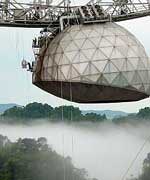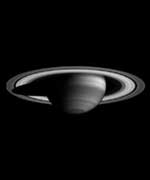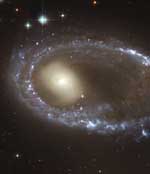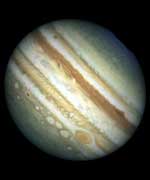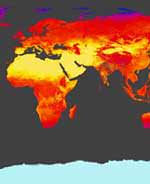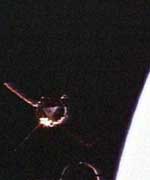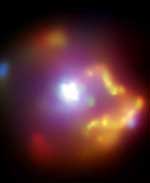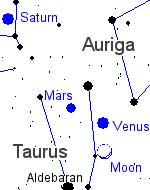
Image credit: NASA
It’s happening again: the Moon and a bunch of planets are gathering in the evening sky.
Unlike last month, when five bright planets (including Mercury) were visible, this time there are only four: Venus, Mars, Saturn and Jupiter. Four is plenty, though. Using only your eyes and, if you have one, a small telescope, you’ll be able to see some wondrous things.
The show begins on Thursday, April 22nd. Step outside after nightfall and look west. The first thing you’ll notice is piercing-bright Venus and, not far below it, the delicate crescent Moon. These are the two brightest objects in the night sky, pleasingly close together. Mars is there, too, albeit not much brighter than an ordinary star. You can find it just above Venus, at one vertex of a Moon-Mars-Venus isosceles triangle.
Point a telescope at Venus and ? it looks just like the Moon! Well, almost. Because it lies between Earth and the Sun, Venus has phases just as our Moon does. At the moment Venus is a fat crescent. It’s colored gray-white, very Moon-like, but unlike the Moon, Venus is featureless. Thick uniform clouds hide the planet’s surface; the most powerful telescopes on Earth can’t penetrate them.
The crescent Moon is more fun to look at through a telescope. Low-slanting rays from the sun cast long shadows from lunar mountains. You can see impact craters, valleys and rilles ? all cast into sharp relief.
Can you also see a ghostly glow across the Moon’s dark terrain? For millennia the glow was a mystery, until Leonardo da Vinci figured it out in the 16th century. It is sunlight reflected from Earth onto the Moon. Modern astronomers call the glow Earthshine, and it’s one of the loveliest sights in the heavens–no telescope required.
The triangle shifts on Friday, April 23rd, as the Moon moves past Venus to a spot right beside Mars. This is the best night to find Mars, dim and red, using the Moon as a guidepost. Seen through a telescope Mars is not very impressive, not like it was in August 2003 when the planet made a historic close approach to Earth.
On Saturday, April 24th, the Moon glides away from Mars and toward Saturn, which looks like a bright yellow star. With the Moon beside Saturn to mark its location, you can’t miss it. Point your telescope at Saturn: Even a small ‘scope will show the planet’s lovely rings and it’s biggest moon Titan.
The NASA-ESA Cassini spacecraft is en route to Saturn now, due to arrive in July. Cassini will orbit for four years, studying Saturn’s rings, weather and magnetic field. Cassini will also drop a probe named Huygens through the thick orange clouds of Titan to discover what lies beneath.
Titan is one of the most mysterious worlds in the solar system. It has a nitrogen atmosphere denser than Earth’s and clouds laced with organic compounds. Some researchers believe there might be puddles, lakes or even oceans of liquid hydrocarbons sloshing around on the surface. These are places where organic molecules might get together for the first stirrings of simple life.
Through a backyard telescope Titan looks like an 8th magnitude star, an unremarkable pinprick. In fact, Titan is bigger than Mercury and Pluto. If it orbited the sun it would surely be considered a planet. What do the clouds of Titan hide? It’s something to think about while you’re peering through the eyepiece.
Finally on Thursday, April 29th, the Moon glides by Jupiter. You’ve probably noticed Jupiter before: it hangs almost directly overhead at sunset and outshines everything in the sky except Venus and the Moon. The Moon and Jupiter side by side are a pleasing sight.
Look at Jupiter through a telescope and you’ll see the planet’s rust-colored cloud belts and its four largest moons: Io, Europa, Callisto, and Ganymede. You might also see the Great Red Spot–a hurricane twice as wide as Earth and at least 100 years old. On April 29th it will be crossing Jupiter’s middle (as seen from Earth) at 09:12 p.m. PDT or 04:12 UT on April 30th.
Four planets, six moons, Earthshine, lunar mountains, the phases of Venus, a planet-sized hurricane and Saturn’s rings: Mark your calendar and see them all before April is done.
Original Source: NASA Science Story

